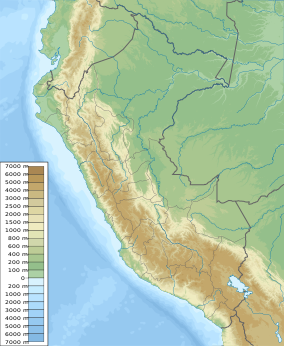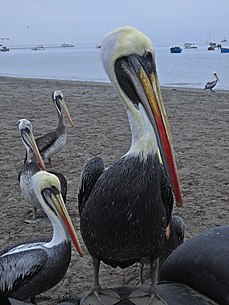| Paracas National Reserve | |
|---|---|
| Reserva Nacional de Paracas | |
| IUCN category VI (protected area with sustainable use of natural resources) | |
 Supay beach, at Paracas National Reserve. Supay beach, at Paracas National Reserve. | |
 | |
| Location | Ica |
| Nearest city | Pisco |
| Coordinates | 13°53′43.5″S 76°16′15.9″W / 13.895417°S 76.271083°W / -13.895417; -76.271083 |
| Area | 3350 km² |
| Established | 25 September 1975 |
| Governing body | SERNANP |
| Website | Reserva Nacional de Paracas (in Spanish) |
| Ramsar Wetland | |
| Official name | Paracas |
| Designated | 30 March 1992 |
| Reference no. | 545 |
Paracas National Reserve is a protected area in the region of Ica, Peru and protects desert and marine ecosystems for their conservation and sustainable use. There are also archaeological remains of the Paracas culture inside the reserve.
Geography
The reserve is located in the region of Ica, 250 km south of Lima, and a few kilometres from the town of Pisco. It spans an area of 335,000 hectares, 65% of which correspond to marine ecosystems. The highest elevation in the reserve is 786 m.
The reserve includes coastal geographic features such as: the Paracas Peninsula, Independencia Bay, San Gallán Island, Paracas Bay and Independencia Island.
Climate
| Pisco | ||||||||||||||||||||||||||||||||||||||||||||||||||||||||||||
|---|---|---|---|---|---|---|---|---|---|---|---|---|---|---|---|---|---|---|---|---|---|---|---|---|---|---|---|---|---|---|---|---|---|---|---|---|---|---|---|---|---|---|---|---|---|---|---|---|---|---|---|---|---|---|---|---|---|---|---|---|
| Climate chart (explanation) | ||||||||||||||||||||||||||||||||||||||||||||||||||||||||||||
| ||||||||||||||||||||||||||||||||||||||||||||||||||||||||||||
| ||||||||||||||||||||||||||||||||||||||||||||||||||||||||||||
Paracas National Reserve is an arid zone, with intense local winds known as paracas. Precipitation is scarce and occurs in winter, falling mostly on the top of the highest hills, which is vital to the lomas ecosystem. The following climograph corresponds to the nearby town of Pisco (19 m of elevation).
Ecology
Flora
Some terrestrial plant species found in the reserve are: Tiquilia paronychoides, Prosopis pallida, Distichlis spicata, Tillandsia spp., Eriosyce omasensis, Geoffroea decorticans, Sesuvium portulacastrum, Cressa truxillensis, Geranium limae, Suaeda foliosa and Oxalis carnosa.
Marine algae found in the reserve include: Ulva lactuca, Chondracanthus chamissoi, Macrocystis pyrifera and Pyropia columbina.
Fauna
The Paracas National Reserve houses a great biological diversity, especially in the marine-coastal part. It is estimated that there are about 216 species of birds, 36 of mammals, 10 of reptiles, 168 of fish and a large number of invertebrates that are an initial part of the trophic chain of this important place.
Mammals found in the reserve include: the sei whale, South American fur seal, dusky dolphin, marine otter, sperm whale, humpback whale, South American sea lion, killer whale, common bottlenose dolphin and southern right whale.
Birds found in the reserve include: the Andean condor, Chilean flamingo, spotted sandpiper, oasis hummingbird, Peruvian pelican, Inca tern, black skimmer, Humboldt penguin, guanay cormorant, Peruvian thick-knee, Andean swift and Peruvian diving petrel. The reserve has been designated an Important Bird Area (IBA) by BirdLife International because it supports significant populations of several bird species.
Molluscs found in the area include: Argopecten purpuratus, Concholepas concholepas, Thais chocolata, Fissurella maxima, Glaucus atlanticus, Choromytilus chorus and Aulacomya atra.
Fish found in the reserve include: Peruvian hake, flathead grey mullet, skipjack tuna, blue flyingfish, humpback smooth-hound, copper shark, Peruvian anchoveta, eastern Pacific bonito, Peruvian eagle ray, fine flounder, blue shark, corvina and bigeye tuna.
Archaeology
There are more than 100 archaeological sites identified inside the reserve, many of them of the Paracas culture, known especially for their textile crafts.
Recreation
Beach tourism and wildlife observation are the main activities in the reserve.

Gallery
-
 La Catedral, January 2007
La Catedral, January 2007
-
 La Catedral, November 2000
La Catedral, November 2000
-
A November 2000 view from within what used to be the Cathedral cave, which was destroyed in earthquake of 2007
-
 The red beach in Paracas National Reserve
The red beach in Paracas National Reserve
See also

References
- "Paracas". Ramsar Sites Information Service. Retrieved 25 April 2018.
- ^ "De Paracas - Servicio Nacional de Áreas Naturales Protegidas por el Estado". www.sernanp.gob.pe (in European Spanish). Retrieved 2018-11-09.
- ^ "Paracas National Reserve - Park Profile - Geography". www.parkswatch.org. Retrieved 2018-11-11.
- ^ Plan Maestro - Reserva Nacional de Paracas 2003-2007 (in Spanish). SERNANP. 2002. pp. 43, 164–165, 179–180.
- ^ Johnston, Ivan M. (1931). "The Vascular Flora of the Guano Islands of Peru". Contributions from the Gray Herbarium of Harvard University (95): 26–35. doi:10.5962/p.336136. JSTOR 41764132. S2CID 249076017.
- "Pisco climate: Average Temperature, weather by month, Pisco weather averages - Climate-Data.org". en.climate-data.org. Retrieved 2018-11-10.
- ^ "Paracas National Reserve - Park Profile - Biodiversity". www.parkswatch.org. Retrieved 2018-11-10.
- Paracas National Reserve: 40 years (in Spanish and English). SERNANP. 2015. p. 111.
- Ramírez, M. E.; Santelices, B. (1991). "Catalogo de las algas marinas bentonicas de la costa temperada del Pacifico de Sudamerica". Monografias Biologicas (in Spanish). 5: 1–437.
- "Pyropia columbina (Montagne) W.A.Nelson :: Algaebase". www.algaebase.org. Retrieved 2018-11-10.
- "Reserva Nacional de Paracas". BirdLife Data Zone. BirdLife International. 2024. Retrieved 2024-10-02.
External links
| Protected areas of Peru | |
|---|---|
| National Parks | |
| National Sanctuaries | |
| Historic Sanctuaries | |
| National Reserves | |
| Wildlife Refuges | |
| Landscape Reserves | |
| Communal Reserves | |
| National Forests | |
| Protection Forests | |
| Game Reserves | |
| Reserved Zones | |
| Regional Conservation Areas | |
| Private Conservation Areas | |